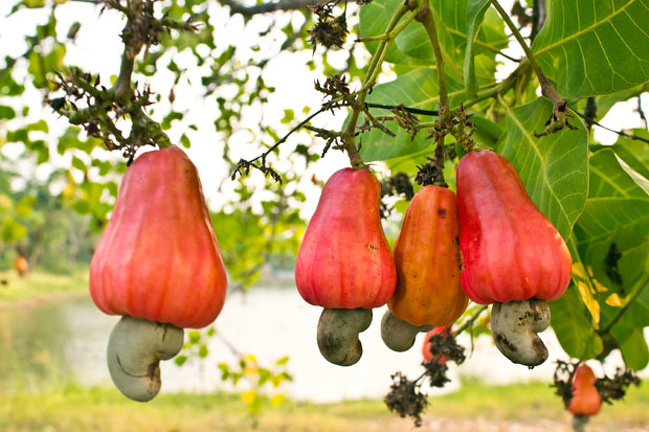1. Fugu (pufferfish)

Want to talk about knife-edge play? It defintiely has a lot to do with this fish. This “cutie”, a tasty Japanese delicacy, contains a deadly poison — tetrodotoxin — in its skin, ovaries, gonads, and liver.
Chefs must be specially qualified to prepare this dish and be able to work around the dangerous organs. Training usually takes three or more years, and the restaurant preparation of fugu is strictly controlled by the Japanese law. For instance, serving liver was banned back in 1984, since it is the most poisonous (yet tastiest) part.
As of now, there is no antidote for fugu poison!
2. Monkey brains

Perceived as a delicacy by some and as cruelty by others, this meal is presumably consumed in some Asian and African tribes. However, there’s no official knowledge of this, so hopefully this tradition is being condemned. In today’s China, for instance, serving monkey brains is punishable by up to 10 years in prison.
The danger of eating this meal is something called Creutzfeldt—Jakob disease that severely damagesthe human brain and can be fatal.
3. Cashews

“Wait, what?” — you may ask, since we all like to snack on this tasty nut, native to Brazil. And then be startled again when we tell you: never eat them raw!
It’s not a widely known fact, but “raw” cashews that you see on the supermarket shelves have in reality been steamed to remove urushiol, a chemical that is also found in poison ivy. High levels of urushiol can be fatal.
And yes, this is what cashews growing on a tree look like!
4. Hákarl
A specialty of Iceland, Hákarl is actually a dish made with Greenland shark that has neither a kidney nor a urinary tract, so all the body’s toxins are absorbed directly into its skin. Normally Hákarl is cured with a special fermentation process and hung up to dry for 5-6 months.
This dish is served with rye bread, and some people actually complain that it doesn’t taste good. But let’s at least hope it was prepared just right!
5. Pangium edule (the “football fruit”)

With such a simple look, this sweet and aromatic fruit native to East Asia — Malaysia, actually requires a complicated preparation. That is, of course, if you don’t want the poison — hydrogen cyanide — to get to you.
So the recipe goes like this: boil the seeds without their shells, then bury in banana leaves, ash, and earth for forty days. Or stay on the safe side, despite the fact that the football fruit is actually an excellent source of vitamin C and iron!
6. Sannakji (live octopus)

This dish is popular in South Korea and Japan and not meant for the weak of heart. Are you ready to swallow something that is still moving?
The danger is that the octopus’ suction cups still have their gripping power, even if the animal is already dead. This results in about 6 deaths per year due to suffocation. In order to prevent it, chew carefully or ask to have it sliced into small pieces.
7. Blood clams

Cultivated in Southeast Asia, this clam got its name because of the red hemoglobin liquid inside its soft tissues.
Consuming it is pretty dangerous, as these species live in low-oxygen environments and need to feed on viruses and bacteria, including hepatitis A, hepatitis E, typhoid, and dysentery to get by.
The traditional Shanghai method of cooking blood clams involves only quick boiling, so most of the pathogenic organisms survive and account for a high infection rate among consumers, which is a shame, becaue they are reported to be deliciously crispy and delicate in flavor.
8. Cassava (manioc)

This root vegetable is a popular meal in developing countries, as it provides useful nutrients and resistant starch. Native to South America, it is now cultivated in many tropical regions.
However, if eaten raw, cassava can produce cyanide — a deadly substance for the human body. To be on the safe side, you need to boil, mash, grill, fry, bake, or steam it.
Also, if you are allergic to latex rubber, you’ll most likely be allergic to cassava, so beware!
9. Elderberries

These berries look pretty yummy and grow worldwide, but definitely have a gloomy side. Their leaves, seeds, and twigs contain cyanide, so you need to remove them AND eat elderberries only fully ripe and properly cooked.
Otherwise the not-so-fun symptoms like severe diarrhea and seizures may occur. However, elderberries are reported to help fight viruses including the flu and reduce inflammation.
10. Ackee

This mysterious (and weird-looking) fruit can cause Jamaican vomiting sickness, which is not fun at all and can actually be lethal. The irony is that ackee is actually the national fruit of Jamaica!
In order to enjoy your exotic meal, native to West Africa, remove the black seeds and eat ackee fully ripe. That way you’ll avoid the toxins hypoglycin A and hypoglycin B that cause the sickness.
We know that, depending on your personality, this list will either urge you to be on the safe side or push you to test your luck and feel the adrenaline. But we hope that in any case it will leave you equipped with knowledge and precautionary techniques.
Tell us in the comments: are you the type of person who’d take this type of risk? What was the riskiest thing you’ve ever done?












RSS